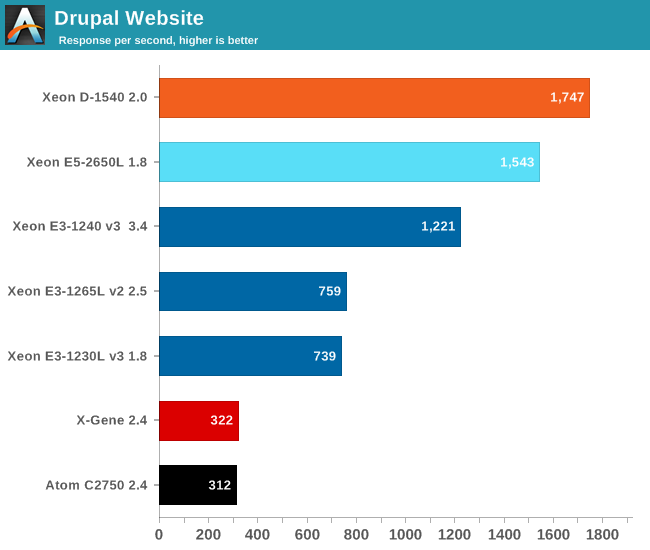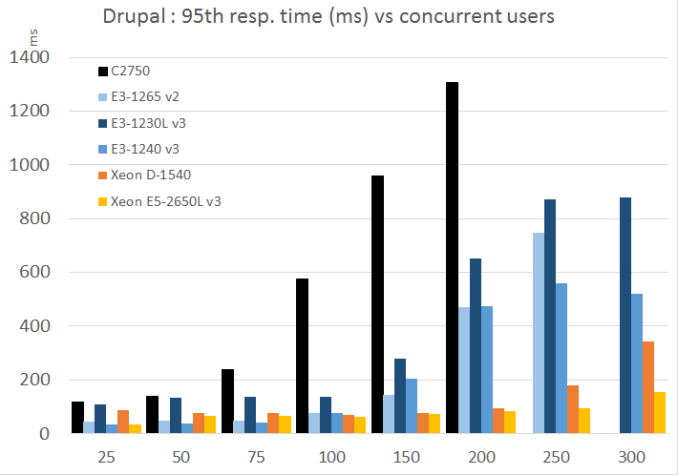The Intel Xeon D Review: Performance Per Watt Server SoC Champion?
by Johan De Gelas on June 23, 2015 8:35 AM EST- Posted in
- CPUs
- Intel
- Xeon-D
- Broadwell-DE
Web Server Performance
Websites based on the LAMP stack - Linux, Apache, MySQL, and PHP - are very popular. Few people write html/PHP code from scratch these days, so we turned to a Drupal 7.21 based site. The web server is Apache 2.4.7 and the database is MySQL 5.5.38 on top of Ubuntu 14.04 LTS.
Drupal powers massive sites (e.g. The Economist and MTV Europe) and has a reputation of being a hardware resource hog. That is a price more and more developers happily pay for lowering the time to market of their work. We tested the Drupal website with our vApus stress testing framework and increased the number of connections from 5 to 300.
We report the maximum throughput achievable with 95% percent of request being handled faster than 1000 ms.

Let us be honest: the graph above is not telling you everything. The truth is that, on the Xeon D and Xeon E5, we ran into several other bottlenecks (OS and Database related) before we ever could measure a 1000 ms 95th percentile response time. So the actual throughput at 1 second response time is higher.
Basically, the performance of the Xeon D and Xeon E5 was too high for our current benchmark setup. Let us zoom in a bit to get a more accurate picture. The picture below shows you the 95th percentile of the response time (Y-axis) versus the amount of concurrent requests/users (X-axis). We did not show the results of the Atom C2750 beyond 200 req/s to keep the graph readable.
We warm up the machine with 5 concurrent requests, but that is not enough for some servers. Notice that the response time of the Xeon D between 50 and 200 requests per second is lower than at 25 request per second. So let us start our analyses at 50 request per second.
The Xeon E3-1230L clock speed fluctuates between 1.8, 2.3 and 2.8 GHz. It is amazing low power chip, but you pay a price: the 95th percentile never goes below 100 ms. The highly clocked Xeon E3s like the 1240 keeps the response time below 100 ms unless your website is hit more than 100 times per second.
The Xeon D once again delivers astonishing performance. Unless the load is more than 200 concurrent requests per second, the server responds within 100 ms. There is more. Imagine that you want to keep your 95th percentile. response time below half a second. With a previous generation Xeon E3, even the 80W chip will hit that limit at around 200-250 requests per second. The Xeon D sustains about 800 (!) requests per second (not shown on graph) before a small percentage of the users will experience that response time. In other words, you can sustain up to 4 times as manyhits with the Xeon D-1540 compared to the E3.











90 Comments
View All Comments
Kjella - Tuesday, June 23, 2015 - link
Server on a chip? It's not intended for use with a display, it does all it's "supposed to" do for the hyperscale market without any display.close - Tuesday, June 23, 2015 - link
"Intel was able to combine 8 of them together with dual 10 Gbit, 4 USB 3.0 controllers, 6 SATA 3 controller and quite a bit more".This ^^ makes it a SoC. Ok, a video output would be nice but that certainly doesn't disqualify it.
ats - Tuesday, June 23, 2015 - link
cause video isn't required or even wanted in this market segment. It is a SoC, which simply means system on a chip and doesn't have some ironclad definition. Hell, most "SoC" chips aren't really systems on a chip anyways and require significant supporting logic (this is true for just about any cell phone SoC on the market too).bill.rookard - Tuesday, June 23, 2015 - link
Exactly, you would tend to use remote management over the network to admin this type of a unit. I have several rackmounted servers in my basement (I do some home-serving of websites over a business class connection) and while I do have them actually hooked up to a display, I can hardly remember the last time I looked at them as 99.9% of the time I SSH into everything for administration.About the only time you'd ever really use a display is if you were doing multiple VMs of assorted types. Beyond that, it's wattage wasted.
ats - Tuesday, June 23, 2015 - link
Yeah honestly, having several SM boards with their ILM system, the only time I'd ever hook up a display is if the network was down. The SM ILM will fully proxy pretty much anything you want and give you a 1200p display that works for just about anything. And you can remotely hook up CDs, DVDs, BRs, USB, etc through it along with the stand console and keyboard/mouse functions. Its a very nice solution.nightbringer57 - Tuesday, June 23, 2015 - link
Basically, you don't need video output.Even if you do, mainboard manufacturers usually include a third-party chip with dedicated functions that, along other things, provide a VGA port usable for a server use.
In this case, the AST2400 chip offers some basic GPU functions with a VGA port along with many remote control-related stuff.
Adding all those functions to the Intel SoC would be awfully expensive. The chip only requires a simple PCIe x1 connection from the SoC, but provides hundreds of additional pins. Not only would those functions probably be hard to implement on a relatively recent 14nm process, but it would require at least 300 new pins on the SoC to add all the 3rd party chip's functions on it, which is almost impossible to do.
Th-z - Tuesday, June 23, 2015 - link
There doesn't seem to have a concrete definition for the term SoC, but it's ridiculous now with the term SoC bandwagon. Everything seems to be called "SoC" these days as long as a chip has more than one functions integrated. One of examples is people even called current console's integrated CPU and GPU chip as SoC, which doesn't even have networking and other peripheral units in it. When a system has so many "SoCs" inside, the term really has lost its meaning and significance.redzo - Tuesday, June 23, 2015 - link
I'm thinking this is a bad name for a product like this. It reminds of the infamous Celeron D and Pentium D line.nandnandnand - Tuesday, June 23, 2015 - link
Anyone who can figure out Xeon D exists can probably tell the differencewussupi83 - Tuesday, June 23, 2015 - link
I agree with redzo, I think anyone who can figure out a 'Xeon D' exists AND remembers that Pentium & Celeron D's existed would initially assume this is a budget Xeon - which it's clearly not. E4 sounds pretty logical. But sure lets just put D...